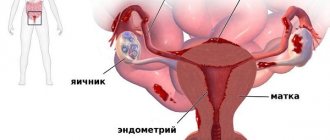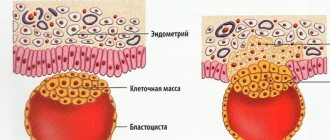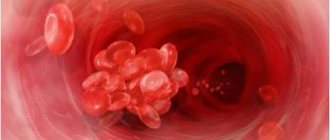- January 19, 2019
- Gynecology
- Olga Simchenko
It often happens that a woman experiences heavy bleeding during menstruation for no apparent reason. It is very important to know what to do about this to prevent complications from developing. Severe bleeding with clots threatens the development of anemia, as well as more serious diseases.
To eliminate the unpleasant consequences of this condition, you need to initially study the causes of its occurrence and methods of treatment. Therapy can be carried out using hemostatic drugs or folk remedies.
Causes of heavy bleeding during menstruation
The amount of blood released may vary from woman to woman. If menstruation occurs regularly, and the amount of discharge in each new cycle does not differ much, we can assume that too scanty or heavy periods are an individual characteristic of the body. If heavy discharge occurs suddenly, you should consult a doctor.
Possible causes of heavy bleeding:
- Hormonal disorders. If estrogen levels increase abruptly, endometrial cells (the tissue lining the inner walls of the uterus) also actively divide, increasing their numbers. This leads to their detachment and blood clots appear. Changes in hormonal levels can occur during menopause, after severe stress.
- Endometriosis. In some women of childbearing age, the endometrium begins to grow pathologically. Sometimes its cells are found in other tissues and organs of the body and grow into the muscular layer of the uterus. This leads not only to heavy bleeding, but can also cause complications - infertility, the development of fibroids, pain during bowel movements.
- Myomatosis. Sometimes muscle cells in the uterus begin to grow and multiply, forming a lump or lump called a fibroid. This formation is considered a benign tumor and can be successfully treated. Patients with a similar diagnosis may complain of heavy and prolonged menstruation, pain during menstruation. Some types of fibroids can cause infertility or contribute to miscarriages.
- Chronic inflammation of the ovaries and fallopian tubes are common causes of bleeding. Such diseases can be caused by bacteria (staphylococcus, streptococcus, Escherichia coli and tuberculosis bacilli). As a rule, the inflammatory process leads to the formation of adhesions - the folds of the fallopian tubes grow together. This can cause cavities to appear in which pus or blood accumulate.
- Surgeries on the uterus or other reproductive organs.
Classification and reasons
There are chronic and acute abnormal bleeding. Chronic includes all types of atypical bleeding from the uterus that last more than six months and do not require immediate medical attention.
An acute condition includes sudden heavy (profuse) bleeding that occurs against a chronic background or occurs for the first time. Acute uterine blood loss requires urgent medical intervention.
Bleeding is not a disease itself, but only a symptom that a certain malfunction has occurred in a woman’s body. Simply stopping the bleeding without understanding the causes of the anomaly will not solve the problem. The cause of bleeding can be both organic disorders (diseases) and functional disorders without visible physical changes.
Dysfunctional uterine bleeding (DUB)
The causes of the pathology in this case may be disturbances in the functioning of the pituitary gland, hypothalamus, and ovaries, as a result of which the balanced production of hormones is disrupted. Organic damage to tissues and organs may not be detected.
There are two types of DMC:
- Ovulatory. The discharge can be scanty, spotting, and occur before menstruation, after it ends, or in the middle of the cycle. Ovulation occurs, but conception and pregnancy can be problematic due to hormonal imbalances. It is characterized by various irregularities of the menstrual cycle, deviations in duration, frequency, and amount of discharge in any direction from the norm.
- Anovulatory. The monthly cycle passes without ovulation. Characterized by heavy, prolonged bleeding after a delay or occurring as a continuation of normal menstruation.
Hormonal causes of bleeding in women also include functional disorders of the thyroid gland with an increase or decrease in the production of thyroid hormones.
Organic bleeding
Diseases of internal organs or pathological changes in tissue structure that can provoke abnormal bleeding:
- endometrial pathology (hyperplastic process);
- ovarian tumors;
- polyps;
- uterine fibroids;
- inflammation and infections;
- malignant formations of different localization;
- systemic diseases affecting hematopoiesis.
The classification of uterine bleeding according to its causes is conditional. With a comprehensive examination, several causes, both organic and dysfunctional, can be diagnosed simultaneously.
Breakthrough bleeding
Iatrogenic bleeding, otherwise called “breakthrough” bleeding, occurs while taking hormonal drugs (including contraceptives), anticoagulants or other medications. The same reaction can be provoked by surgical interventions or trauma to the uterus when the intrauterine device is displaced.
Iatrogenic bleeding does not have dangerous profuseness or duration, but requires immediate consultation with the treating gynecologist to change drug treatment or immediately remove the IUD.
Unlike breakthrough bleeding, profuse bleeding develops rapidly, and blood loss can be large. A distinctive feature of the profuse process is painlessness.
Types of bleeding during menstruation
When examining the patient, the gynecologist finds out how menstruation is going. Most often, the doctor asks whether the discharge is heavy or scanty, whether it has an unpleasant odor, and how many days the menstrual period lasts. Based on the examination and the woman’s answers, the gynecologist makes a conclusion about whether there are any pathologies. You should find out when you can talk about the norm, and when menstruation is considered pathological.
Normal discharge
Normally, the menstrual cycle should be the same in time - take from 21 to 34 days. In rare cases it may be slightly shorter or longer. A cycle is the number of days from the start of menstruation to the date preceding the onset of the next critical days. Signs of normal discharge:
- color - from blurry pink, rich red to burgundy;
- consistency – liquid on the first day, creamy in the middle of the menstrual period, sometimes heterogeneous with clots;
- volume – from 20 to 60 ml per day;
- duration – from 3 to 6 days;
- intensity - at first the discharge is scanty, then it becomes more abundant and soon begins to decrease;
- the smell is of raw meat with a slight musky tint.
Pathological bleeding
Typically, pathology refers to significant deviations from the norm. Pathological bleeding has the following differences:
- the color of the discharge is bright scarlet, opaque;
- consistency – liquid, without clots;
- volume – from 70 ml per day or more;
- intensity – constant or increasing, blood flows continuously;
- smell – absent or unpleasant, putrid.
Sometimes thirst occurs, the pulse quickens, and blood pressure can drop significantly. These symptoms are a reason to immediately consult a doctor.
Possible causes of heavy discharge and uterine bleeding
As already mentioned, sometimes the discharge during menstruation can be heavy. Of course, this causes incredible discomfort and even causes panic. Therefore, it is important to understand why this happens.
The very first and most important thing is to go to the gynecologist. And if you think that you can plan a trip to this doctor in the absence of menstruation, then you are mistaken. If you are worried that these days are not going as expected, under no circumstances should you put off going to the gynecologist. The doctor will be able to draw conclusions about the nature of the discharge and the cause of excessive abundance through an examination in a gynecological chair, ultrasound, smears and blood tests.
In any suspicious case, consultation with a gynecologist is necessary!
There are several reasons why the discharge becomes profuse and even bleeding:
- endometriosis is a disease of the lining of the uterus. When a large amount of endometrium is detached, the discharge increases greatly;
- fibroids are a benign tumor that forms in the uterine cavity and provokes prolonged periods with the release of a large volume of blood. Fibroids are characteristic of reproductive age. After menopause, it decreases on its own;
- can also cause blood loss ;
- disruption of hormone levels. The hormonal system can also affect the number of endometrial cells, which in turn leads to an increase in the volume of discharge;
- intoxication of the female body, which is caused by loss of strength from grueling and frequent diets;
- the onset of menopause. During this period, the level of hormones changes greatly, which can lead to bleeding;
- termination of pregnancy or consequences of abortion/cesarean section. Menstruation during pregnancy requires special attention, as it often indicates irregularities and is actually bleeding. Therefore, we recommend reading the material on the topic “Menstruations during pregnancy” ;
- ectopic pregnancy. By the way, many believe that this is signaled by early menstruation, which came much ahead of schedule. But we invite you to read more information on this topic in our material “Causes of menstruation ahead of schedule”;
- postoperative and post-traumatic period;
- poor blood clotting and tendency to thrombosis;
- the presence of various infectious diseases or inflammatory processes;
- banal nervous tension and fatigue;
- excessive physical activity.
Important: But the cause of bleeding can be much more complicated - it could be uterine tuberculosis, various types of ovarian diseases, a cyst or even genital cancer!
Sometimes this can be a consequence of serious illnesses.
It is after studying the research results that the doctor will be able to give recommendations to eliminate your problem. You should not prescribe medications or procedures yourself.
- It happens that strong discharge appears very suddenly during menstruation - this can be after sleep, when we have been in a horizontal position for a long time. Or simply if you sit for a long time and then suddenly stand up. In this case, you don't have to worry. It’s just that the blood had time to clot a little while you were still.
- Postpartum discharge also resembles bleeding. They are called lochia, and this is a completely separate topic. They should not be confused with the pathology of uterine bleeding. But if the lochia is over, and instead a bright red discharge begins, then this is a reason to consult a doctor. By the way, you can read about the period and duration of menstruation after childbirth in our topic “When do the critical days after childbirth begin and how long do they last?”
Important: It is especially important to take care of your body during critical days. Don't lift weights and slightly limit your workouts and any physical activity. Avoid having sex, as during this period the uterus becomes vulnerable to any kind of infection!
Don't self-medicate!
How to distinguish heavy discharge during menstruation from uterine bleeding?
A distinctive sign of the pathological condition is atypically heavy discharge. If your periods were previously uneventful, but at the moment they are too intense, you should be wary. If the volume of discharge does not decrease during the day and is about 100 ml, you should consult a doctor. Other features are also taken into account:
- deterioration of health, weakness, dizziness, severe pain in the lower abdomen;
- constant or increasing intensity of discharge;
- Pads or tampons have to be changed more than once an hour.
The table shows the main drugs to stop bleeding, as well as drugs that help restore blood volume.
| Name of the drug, release form | Active substance | Contraindications |
| Dicynone (Etamsylate), tablets | Etamsylate is a hemostatic agent that affects the first stage of the hemostasis mechanism. Increases platelet adhesiveness and strengthens vessel walls. | Hypersensitivity to ethamsylate, asthma, porphyria, increased blood clotting, hemoblastosis, thrombosis |
| Vikasol, ampoules | Menadione sodium bisulfite. It is a synthetic analogue of vitamin K, normalizes the process of blood clotting. | Thromboembolism, increased blood clotting |
| Tranexam, tablets/solution for injection | Tranexamic acid. Suppresses (inhibits) the production of fibrinolysin. Has a systemic and local hemostatic effect. | Hypersensitivity to the components of the drug, thrombosis, renal failure, subarachnoid bleeding |
| Ascorutin, tablets | Contains ascorbic acid and rutin. Has a capillary stabilizing effect. | Hypokalemia, hypercalcemia, increased blood clotting, severe kidney disease |
Dietary features and daily routine
Any bleeding may increase if the body experiences increased physical stress. In this regard, during heavy periods, it is recommended to follow the following rules:
- do not suddenly jump out of bed after sleep;
- do not lift heavy objects;
- avoid stressful situations;
- limit physical activity as much as possible;
- spend more time in a calm environment.
Nutrition should be complete, while it is advisable to limit the consumption of heavy and fatty foods. If there is significant blood loss, you need to make sure that your diet contains iron-containing foods (beef, liver), fresh herbs, vegetables, fruits, and red berries. An excellent addition to the diet would be pomegranate juice and dry red wine (in the absence of contraindications).
Folk remedies
With the help of folk remedies, you can not only reduce bleeding, but also reduce the likelihood of problems in the future. Traditional healers use herbal remedies to treat uterine bleeding. The most popular means:
- Nettle. Due to its antihemorrhagic properties, this plant has long been actively used to stop bleeding. Fresh nettle juice works more effectively because it contains more vitamin K. In case of uterine bleeding, you need to drink a decoction of dried leaves 2-3 times a day, ½ cup.
- Peppermint (or water pepper). The plant extract can be purchased at the pharmacy, or you can prepare it yourself. To do this, you need to pour 15 g of dry grass with 200 g of vodka and let it brew in a dark place for 14 days. Take 10 drops 3 times a day.
- Shepherd's purse. Prepare a decoction from the plant according to the classic recipe (2 tablespoons of herb, pour 1 tablespoon of boiling water and leave in a water bath for 40 minutes). Strain and drink 1 tbsp. three times a day.
- Herbal collection. 2 tbsp. collection (oak bark and St. John's wort in equal proportions) pour a glass of water at room temperature and heat over low heat, without boiling, for 10–15 minutes. Then let it brew for about an hour and strain. Drink half a glass 2 times a day.
What drugs are the most effective?
Modern hemostatic drugs have a wide spectrum of action and different prices. In emergency cases, the following medications are used to stop bleeding during menstruation:
| Hemostatics: | Mechanism of action: |
| Vikasol | An antihemorrhagic agent used in gynecology to reduce the profuseness of menstruation, stop uterine bleeding after trauma, surgery, and wounds. Normalizes the blood clotting process, replenishes vitamin K deficiency. The daily dose and course of use are determined individually. |
| Dicynone | Used to prevent and stop blood loss of various etiologies: metrorrhagia, primary menorrhagia, fibroids. Reception begins 5 days before menstruation, 3 tablets with meals, for 10 days. The following side effects are possible with the use of Dicynon: swelling and flushing of the face, nausea, headache in the eyes and forehead. |
| Tranexam | It has a wide spectrum of action, has a hemostatic, anti-inflammatory, analgesic effect. Enhances fibrinolysis during heavy and frequent menstruation, postpartum hemorrhage, and surgical interventions. Dosage regimen: three times a day for 3-4 days. The development of side effects from the central nervous system, allergic reactions, subarachnoid hemorrhage is possible. |
| Etamzilat | A popular drug prescribed by gynecologists to reduce blood loss during menstruation, surgical interventions, and uterine bleeding. According to the instructions, the daily dose should not exceed 0.25 g (2 tablets), distributed into 4 doses. The duration of the appointment is determined by the attending physician. Contraindications: thrombosis, hemorrhage, individual intolerance. |
After stopping the bleeding, to restore the body and lost blood volume, it is recommended to take vitamin complexes, iron-containing products, and ascorbic acid.
Prevention of recurrent bleeding
If heavy menstruation occurs frequently, or there have been cases of uterine bleeding, it is worth paying attention to prevention. Effective and proven ways to prevent bleeding:
- take water pepper extract;
- limit physical activity during menstruation;
- visit a gynecologist regularly (once every six months);
- during menstruation, avoid eating foods that thin the blood (mint, beets, olive oil);
- give up Aspirin and medications that contain acetylsalicylic acid (Citramon).
Heavy periods or bleeding - how not to miss the body's alarm signal?
Menstruation is a cyclical shedding of the inner mucous layer of the uterus. Every woman of reproductive age regularly experiences similar bleeding from the vagina. But when such bleeding is not associated with menstruation, or the nature of menstruation differs from the norm in quantity, time and associated symptoms, this may be the first sign of pathology.
Timely detection of the problem will allow you to avoid serious diseases, including cancer. Read this article to learn how to understand periods or bleeding in teenage girls, women of reproductive and menopausal age.
Normal discharge during menstruation
To distinguish pathological bleeding from natural bleeding, you should know what is acceptable. Menstruation is a natural discharge that is normal and physiological. It has the following characteristics:
- Duration – 3 – 7 days. The period from the first day of menstruation to the beginning of the next takes 21 - 35 days and is defined as the menstrual cycle. On average it is 28 days.
- The first day or two, menstrual bleeding is moderate, then for several days it is heavy, and in the last days it becomes more scanty. The total volume of blood excreted through menstrual flow should not exceed 80 ml. A higher rate leads to the development of anemia.
- Menstruation is typical for women of the reproductive period, with the exception of pregnant and breastfeeding women. It appears regularly from menarche (the first period, coming at the age of 12 - 15 years) and until menopause (45-55 years).
- Painless. Mostly, discharge during menstruation is not accompanied by pain. But in some cases, painful sensations are acceptable, which is due to the characteristics of the body. In any case, pain requires attention from a gynecologist.
- Bloody discharge in the first days has a scarlet tint, which towards the end changes to dark red or brown.
- Blood may be released in the form of clots, often dark in color, but they should not be large. This is how the sloughed endometrium or clotted blood comes out.
Normally, menstruation comes after an equal number of days, in a moderate volume and the same for each cycle, which can be seen by the number of pads or tampons used.
And here is more information about how to distinguish uterine bleeding from menstruation.
Main features
Before we talk about how to stop bleeding during heavy periods, you must first figure out whether they are bleeding. After all, for some women such menstruation is considered the absolute norm and it depends, first of all, on the individual characteristics of the body, as well as on heredity. If heavy periods are not accompanied by weakness and dizziness and are observed in a woman constantly, then there is no need to make any attempts to reduce blood flow, since this can only cause harm.
It is necessary to carry out any actions only if the copious discharge of blood is actually bleeding. It can be determined by the following characteristics:
- Menstruation lasts more than 7 days (not spotting, but blood!).
- A sanitary pad fills up in less than 1.5-2 hours, making it necessary to change it frequently.
- The woman experiences severe weakness, dizziness, pale skin, drop in blood pressure, nausea, and fainting.
In all these cases, it is undoubtedly necessary to act as quickly as possible. Since excessive blood loss can cause a sharp drop in hemoglobin levels, followed by the onset of anemia, characterized by a lack of oxygen in the body. When it is deficient, cells begin to starve and die very quickly. Moreover, first of all, brain cells suffer from a lack of oxygen, which can lead to serious health problems.
In addition, if severe bleeding is not prevented in a timely manner, it can be fatal. Therefore, if a woman has all the signs described above, she should under no circumstances hesitate.
Heavy menstruation
The amount of blood released during menstruation may increase due to various processes. The following concepts are used to describe them:
- menorrhagia – prolonged and heavy menstruation;
- polymenorrhea - a short (less than 21 days) interval between menstruation;
- metrorrhagia - irregular intermenstrual bleeding;
- menometrorrhagia – prolonged heavy blood loss of an irregular nature.
More than usual spotting during menstruation occurs due to stress and emotional stress, climate change, vigorous activity, taking medications and other factors.
The following conditions can also cause bleeding during menstruation:
- endometriosis;
- single or multiple polyps;
- fibroids and other neoplasms;
- frequent abortions;
- disorders associated with blood clotting;
- acute and chronic gynecological ailments;
- infectious and inflammatory processes;
- endocrinological diseases;
- vitamin B deficiency;
- the presence of an intrauterine device.
Watch this video about the signs and methods of diagnosing bleeding:
Age classification
The most common causes of vaginal bleeding in women vary depending on age. There are three age groups in relation to reproductive function.
Juvenile bleeding
This pathology is observed from the time of the first menstruation (menarche) and is typical for girls under 18 years of age. Without knowing how abnormal bleeding differs from the physiological norm, it is easy to confuse them.
At this age, the cause of vaginal bleeding most often lies in the immaturity of the reproductive system. Hormonal balance is just being established, the menstrual cycle is not regular. Disturbances in the production of progesterone, estrogen or follicle-stimulating hormones can cause bleeding. Having become permanent, they lead to anemia, further abnormal development of reproductive function in girls and hormonal infertility in women.
Disorders of the thyroid gland (hyperthyroidism, hypothyroidism) can also cause blood loss both at a young age and in more mature women. But, most often, the cause of pathology in girls is severely suffered infectious diseases that are considered “childhood”: measles, chickenpox, mumps, tonsillitis or influenza.
Bleeding before menarche in girls is extremely rare and requires special attention, as it can be a sign of malignant tumors.
It is important to know! If hormonal imbalances during puberty (during puberty) are not diagnosed and treated, this affects reproductive health during childbearing years. Later, during menopause, problems with gynecology lead to serious complications, including oncology. The disorder is continuous and does not “outgrow” with age, but gets worse.
Bleeding during reproductive age
A third of all women of childbearing age experience the problem of abnormal uterine bleeding. Violation of normal ovarian function is their most common cause.
Among the factors that can provoke ovarian pathology during reproductive age, gynecologists note:
- stress and nervous tension;
- increased physical activity;
- harmful working and living conditions;
- change of climate zone;
- obesity or underweight;
- genital infections and inflammatory processes;
- chronic diseases of the reproductive organs: endometritis, endometriosis, fibroids, polyps, tumors;
- endocrine diseases.
Termination of pregnancy (surgical, medicinal, spontaneous) can also provoke various gynecological disorders accompanied by blood loss.
Bloody discharge during pregnancy indicates a threat to life for both the mother and the fetus. Such pathological conditions are considered separately.
Bleeding in menopause
In the period preceding menopause (menopause), a decrease in the production of female hormones can cause profuse bleeding immediately after a timely period. Such conditions, which recur periodically in women over 40 years of age, are the first signs of approaching menopause, before other symptoms appear.
The naturalness of the process of attenuation of fertile (childbearing) function does not mean that such accompanying phenomena can be ignored. Profuse bleeding can continue for a long time and threaten serious blood loss. In addition, sometimes it indicates the presence or possible development of other organic disorders.
During the period of the most pronounced symptoms of menopause, bleeding may occur due to excessive growth of the endometrium of the uterus and require surgical intervention. Without treatment, the process (adenomyosis, GPE) can spread to neighboring organs and lead to malignant degeneration of the endometrium.
Note! Any postmenopausal bleeding (when there have been no periods for more than a year) should prompt a woman to see a doctor immediately. The risk of cancer at this age is especially high.
How to understand whether it is heavy menstruation or bleeding?
It is important to distinguish these two physiological processes from each other, since non-functional blood loss can have serious consequences. You should pay attention to the following criteria:
- Blood volume. Blood loss during the critical days of one cycle normally ranges from 50 to 80 ml.
- Number of gaskets. If there is more discharge than normal, this can be seen by the number of hygiene products that will be completely filled in literally an hour or two.
- Date of. Every woman monitors her menstrual cycle and knows the start and end date. The occurrence of bleeding outside this period should be a reason for a visit to the doctor, even if there is a suspicion that this is ovulatory or implantation bleeding.
- Hue. During menstruation, the blood released is dark in color, especially in the middle and end. When there is bleeding, it is most often bright red or scarlet.
- Duration. The duration of menstruation ranges from 3 to 7 days. Bloody discharge longer than this period indicates pathology.
The most dangerous types of bleeding are:
- Breakthrough. Often occur as a result of taking hormonal medications or improper placement of the IUD.
- Profuse. They can occur in parallel with critical days, as well as independently of them and are abundant. Often such blood loss cannot be stopped with medication, so curettage is used.
What to do if you are bleeding
If spotting is not associated with menstruation, you should consult a doctor to find out the cause of this phenomenon and receive competent treatment. When diagnosing and prescribing therapy, the patient’s age and other individual factors are taken into account.
Adolescence
In this case, a comprehensive examination by a pediatrician, endocrinologist, neurologist, and hematologist is necessary. The main diagnosis is carried out by a teenage gynecologist, during which he evaluates the anatomy of the internal organs by examining them. In girls who are not sexually active, the examination is carried out through the rectum.
Ultrasound of the pelvic organs, blood tests - general, hormone levels, biochemical, and other examination methods are used.
Therapy for adolescent patients includes the use of the following drugs:
- hemostatic;
- contracting the uterus;
- strengthening vascular walls;
- iron-containing;
- vitamins, including group B;
- hormonal drugs, if necessary, to correct the menstrual cycle.
In adult women
The examination of patients in this group begins with a gynecological examination and subsequent diagnostic curettage of the walls of the uterus and cervical canal. The resulting material is subject to histological examination. Such manipulation is used for medicinal purposes, since it allows you to get rid of non-functional particles of the endometrium, and the mechanical effect helps to contract the uterus and stop bleeding.
If necessary, an examination of the pelvic organs with ultrasound, a hysteroscope is used, and less often, hysterosalpingography and blood tests are performed (for the concentration of hormones, general, and biochemical).
To normalize the menstrual cycle, hormonal medications are prescribed. Drug treatment includes the same drugs as in the adolescent group.
Treatment of abnormal periods by a doctor
Therapy for such menstrual cycle disorders depends on the frequency and nature of bleeding, as well as on the reasons that provoked them. The main goal of treatment by a doctor is to stop bleeding and prevent relapses.
- In addition to the main measure - curettage, infusion therapy is used to replenish blood loss.
- With the development of anemia, as well as a drop in the level of hemoglobin in the blood, oral medications and intramuscular injections are prescribed.
- It is mandatory to use general strengthening drugs - immunostimulants, vitamin complexes.
- If the cause of bleeding is stress or emotional stress, sedatives are prescribed.
Changes during pregnancy
Uterine bleeding during the perinatal period is generally a dangerous sign; it may indicate the following pathologies:
- Miscarriage. Along with intense discharge, pain and malaise are felt.
- Ectopic pregnancy. Bleeding is accompanied by severe pain, dizziness, and nausea. The main danger with this pathology is pipe rupture. Failure to take timely measures can even lead to death.
- Placental abruption. In this case, bleeding can have different intensity, the tone of the uterus and the activity of the fetus increases, and nagging pain is felt in the lower abdomen.
- Placenta previa. Characteristic of the 2nd and 3rd trimesters of the perinatal period. Uterine bleeding occurs due to a low-lying placenta blocking the exit from the uterus. The discharge is most often not accompanied by pain.
Implantation bleeding
By this sign you can determine the onset of pregnancy. Most often it coincides with the middle of the menstrual cycle. Bleeding occurs when a fertilized egg is implanted into the uterine cavity, when microdamage to the endometrium is formed.
However, this is not entirely the norm. In this case, the blood has a light shade, and the discharge does not last long and is not accompanied by painful sensations. A characteristic feature of the implantation process is a jump in basal temperature: after falling below 37 degrees, it sharply increases to 37 - 37.5 degrees.
source
Causes of heavy bleeding during menstruation, treatment, what to do
Heavy periods are normal for some women. Severe bleeding is considered a feature of physiology, the structure of the genital organs and blood vessels. But most often they occur in pathologies due to metabolic or hormonal imbalances. Even if there are no painful sensations, and the cycle is regular, it is advisable to visit a doctor to understand how serious the deviation is and how you can make blood loss during menstruation less noticeable.
- Hormonal disbalance
Signs of uterine bleeding
Often, a woman cannot accurately recognize when she has heavy bleeding during her period. Additionally, you need to monitor your well-being. The main signs of severe bleeding are:
- critical days last more than a week;
- the released blood exceeds the volume of 80 milliliters;
- irregular discharge;
- mainly observed during menopause or before puberty.
As a result of excessive blood loss, a woman may develop anemia. General health deteriorates significantly, headaches, weakness, problems with normal orientation in space, and frequent dizziness appear. Fainting occurs quite often. Bleeding from the nose often occurs, as well as bruises on the body. If heavy bleeding occurs during menstruation, you should immediately consult a doctor.
What is the normal volume of menstrual flow?
It is considered normal if menstruation appears no earlier than 11 and no later than 16 years, lasts 3-7 days, and its total volume is 40-100 ml. The color and consistency of menstrual blood also matter. Usually it is dark red, mucous, and does not contain large clots.
How to measure blood loss
A convenient way to determine blood loss and whether it is normal is to count the number of absorbent sanitary pads that a woman has to use every day during her period. By summing up the number of pads used per day, you can find out approximately how much blood is lost over all days:
- Blood loss is considered “very light” if pads need to be changed 1-2 times a day (this corresponds to 6-9 g of discharge containing blood and mucus).
- For “light discharge”, it is necessary to use 3-4 pads per day (change every 6-8 hours, which corresponds to approximately 10-12 g).
- With “moderate” blood loss, pads need to be replaced once every 4 hours (13-15 g/day is released).
- “Heavy” discharge is considered to be such that the pads need to be changed every 3 hours (up to 18 g of blood is lost per day).
“Very large” blood loss is when the pad leaks every 1-2 hours. In this case, medical attention is already required, since obvious pathology is observed.
Factors that can increase menstrual flow
The amount and consistency of discharge is individual for each woman. They depend on hereditary and congenital features of the structure of the uterus, blood clotting, metabolism, temperament, lifestyle, nutritional system, physique, age. The following factors can affect the nature of the discharge:
- Use of hormonal contraceptives. They are taken to suppress egg maturation and ovulation according to a strictly defined pattern. Violation of the dosage regimen leads to the appearance of heavier than usual menstruation.
- Installation of an intrauterine device. In the first 3 months, periods may be longer and more abundant until the body gets used to the new hormonal levels.
- Use of duphaston and other hormonal medications. Stopping their use leads to a sharp increase in progesterone levels and the onset of copious bleeding after a few days.
- Taking anticoagulants and other medications that can reduce blood clotting.
The intensity increases if during their course the body is subjected to increased physical stress, if the woman experiences emotional stress.
Menstrual bleeding increases after an abortion or uterine surgery, as well as after childbirth. This is to blame not only for changes in hormonal levels, but also for disruption of the internal surface, which stimulates more intensive development of the endometrium. The occurrence of adhesions or scars in the uterine cavity leads to the appearance of clots of coagulated blood in the menstrual flow, resulting from its stagnation.
In adolescents within 2 years after the onset of puberty, as well as in women during the onset of the first menopausal changes, as a result of hormonal instability, heavy bleeding alternates with scanty bleeding during menstruation. Menstruation comes late or, conversely, too often.
Video: Causes of heavy menstrual flow
Medications with hemostatic properties
A gynecologist will tell you how to reduce bleeding during menstruation with intense discharge. You should not take pills on your own, even if they helped a close relative or friend.
For mild disorders, the patient may be prescribed the following medications:
- Dicynone. It works very quickly. Menstruation becomes moderate 3 hours after taking the pill. Dicinon is also prescribed to prevent heavy periods. Intravenous administration of the drug gives results within 20 minutes. Among the side effects, Dicinon can cause heartburn, nausea, hypotension, malaise, itching and skin rashes.
- Ascorutin. The drug works to strengthen the vascular walls, so that the body loses less blood. Take 2 tablets several times a day.
- Calcium gluconate. The medicine increases blood clotting and reduces vascular permeability. First, calcium gluconate is administered intravenously in a dosage of 5–15 ml. Next, the drug is prescribed in tablets, up to 6 pieces. per day.
If your periods are too heavy and a woman doesn’t know what to do because pills don’t help, she can take injections in consultation with her doctor. The drugs Tranexam, Vikasol, Dicinone in ampoules are suitable for injections. Tranexam causes side effects such as allergies, tachycardia, drowsiness, chest pain, dizziness, vomiting, weakness.
Treatment of intense bleeding lasting more than a month requires a different approach. Heavy, prolonged menstruation occurs due to hormonal imbalances. The condition is corrected through complex treatment:
- Prescription of oral contraceptives - Non-Ovlon, Mercilon.
- Medicines for uterine contractions - Oxytocin (administered intravenously or intramuscularly, the first method of injection gives an instant effect).
- Hemostatics - Vikasol, aminocaproic acid normalize the process of blood clotting. Acid is administered intravenously every 4 hours, using 100 ml of a 5% solution each time. Vikasol, a synthetic analogue of vitamin K, is used in the form of tablets and ampoules. Daily dose of solution – 1 – 2 ampoules, tablets – 4 pcs. The effect of the product is felt after 10 – 12 hours.
- To saturate the body with iron - Sorbifer, Fenyuls.
- Pharmacy tinctures – tincture of water pepper, tincture of Lagochilus.
Before taking hemostatic drugs to stop heavy periods, you need to familiarize yourself with their contraindications. For example, Dicinon is prohibited from use in case of individual intolerance to the components, pathologies of the circulatory system, kidneys and liver, increased blood clotting and glucose-lactose deficiency.
Video:
Causes of pathological heavy periods
Severe bleeding with clots can occur during menstruation if a woman has hormonal imbalances in her body or diseases of the uterus and appendages.
Hormonal disbalance
An increased content of estrogen leads to excessive growth of the endometrium and increased bleeding during menstruation. The cause of hyperestrogenism is a violation of the production of hormones of the pituitary gland, thyroid gland and other endocrine organs, the use of contraceptives and hormonal drugs, metabolic disorders and other factors.
Pathologies of pregnancy
Sometimes during pregnancy, due to a lack of progesterone, menstruation does not disappear. If your period comes with a slight delay, and the bleeding afterwards is heavy and painful, this may mean that a miscarriage has occurred at a very early stage.
Menstrual-like bleeding can also be heavy when an ectopic pregnancy occurs.
Diseases
Increased abundance and pain of blood discharge occurs with endometriosis, the presence of uterine tumors (fibroids and cancer), the appearance of tumors in the ovaries, polyps in the endometrium or cervix. Inflammation of the endometrium also causes changes in its structure and increased bleeding during menstruation.
Often, with diseases and hormonal disorders, menstruation turns into uterine bleeding, which also appears between them. The danger of excessive blood loss is that the hemoglobin level decreases due to loss of iron. Sometimes, to stop bleeding, urgent medical attention is required, even complete removal of the endometrium (uterine curettage).
Signs of anemia are nausea, vomiting, weakness, dizziness, headache, fainting, and drop in blood pressure.
Bleeding after menstruation
It is dangerous not only when heavy discharge appears during menstruation, but also if it occurs again a few days after its end. In this case, it is imperative to identify what provokes them through a diagnostic examination. The most common reasons include;
- attachment of the fertilized egg outside the uterine cavity;
- spontaneous termination of pregnancy;
- formation of a cyst in the ovarian area;
- hormonal imbalance;
- infection or inflammation of the pelvic organs.
Normally, this can only happen after taking oral contraceptives. In other cases, you need to consult a doctor, after which you need to adhere to therapy that stops blood loss and replenish the body with the necessary nutrients.
Heavy periods can occur for various reasons. In this case, it is important how you can visit a gynecologist and take measures to stop blood loss. Otherwise, the woman’s well-being may worsen and anemia may develop. The most serious complications are infertility and the formation of hemorrhagic shock, which can lead to death. To identify the disease at an early stage of development and promptly eliminate it, it is recommended to regularly visit a gynecologist.
Treatment
If there is excessive bleeding, leading to a deterioration in general health and loss of ability to work, it is necessary, first of all, to consult a doctor and find out the cause of this anomaly. An examination is carried out using ultrasound and hysteroscopy to study the condition of the endometrium and detect diseases of the uterus and ovaries. A blood test can reveal hormonal disorders and the presence of inflammatory processes.
Based on the examination results, treatment is prescribed and general recommendations are given on how to reduce the amount of menstrual bleeding. In case of hormonal disorders, oral contraceptives (Mersilon, Rigevidon) or progesterone preparations (Duphaston, Utrozhestan), drugs that suppress the production of estrogen in the ovaries (Pregnil) are prescribed. Homeopathic remedies (mastodinon, remens) are used to regulate hormonal levels.
Main reasons
Disruption of the normal menstrual cycle with heavy discharge occurs in a number of cases:
- Uterine fibroids.
- The presence of malignant neoplasms.
- Poor blood clotting.
- Stressful situations, constant nervousness.
- Engaging in strenuous sports, moving heavy weights.
- Genetic predisposition.
- Incorrectly positioned intrauterine device.
- A sharp change in climatic conditions.
There are many reasons for the described pathology. If bleeding is not stopped promptly, life-threatening anemia can develop. If you suspect a malfunction of the normal functioning of the reproductive system, a woman should immediately consult a doctor.
Often the cause of the described condition is a hormonal imbalance in the body.
The inside of the uterus is covered with endometrium (a protective mucous membrane). The action of hormones is aimed at the growth of this layer, which meets the fertilized egg. When progesterone is produced in greater quantities, this membrane thickens greatly, and its discharge is accompanied by the release of a large amount of blood.
During menopause, changes also occur at the hormonal level. Ovarian activity slows down and egg maturation stops. There is a hormonal imbalance, which is the main cause of heavy bleeding. Usually this condition goes away on its own, but in some cases the doctor prescribes hormone-based therapy. This treatment is designed to normalize the woman’s general condition.
Heavy bleeding during menstruation: reasons, how to stop
Bleeding during menstruation - for what reason does it occur, do you need to see a doctor and how can you reduce blood loss on your own? These are all very important and frequently asked questions. After all, many women, both young and approaching menopause, suffer from heavy menstruation. Let's start with the theory.
Norm and pathology
Normally, a woman during menstruation loses no more than 50 grams of blood during all days of menstruation. Usually in the first 2-3 days the bleeding is heavier, and there may be minor pain in the uterine area caused by its contraction. 40-50 grams is moderate discharge. Less than 40 grams is meager.
With a blood loss of 50 to 80 grams, they talk about the possible occurrence of iron deficiency, especially if the woman is not eating well or does not eat enough iron-containing foods. Another sign of iron deficiency is excessive hair loss all over the head.
If blood loss is from 80 to 120 grams, they speak of the need to reduce it with the help of hemostatic or hormonal drugs. And be sure to get checked for iron deficiency.
Don't forget to tell your doctor if you have heavy bleeding during your period with clots, especially if they are large - more than 2 cm. This may indicate significant blood loss. If this has not been observed before, there is a possibility of miscarriage, that is, the woman may be pregnant; termination of pregnancy should also be considered as one of the possible causes of bleeding. Typically, a miscarriage is accompanied by pain in the uterine area, cramps, sometimes fever, nausea, and weakness.
Urgent medical attention, or at least consultation, is needed if there is very heavy bleeding during menstruation, and one sanitary (not daily) pad becomes completely wet in 2 hours or less. Simply, if there is heavy discharge, you can wait for it to end and go for an examination to a gynecologist to discuss this situation.
But, by the way, such emergency situations arise infrequently. The question of uterine bleeding or menstruation usually arises in women around the middle of the cycle. And then doctors, regardless of the abundance of discharge, say that this is precisely bleeding, the so-called dysfunctional. There is a minimum cycle length - 21 days. If blood appears, say, on the 18th day, then you must remember how to distinguish menstruation from bleeding, and that in this case you can and should consult a doctor.
What should menstruation be like?
During menstruation, a woman normally produces 50-80 milliliters of blood. The first days of the cycle pass with bright-colored blood discharge, and then gradually it becomes darker.
The shade of menstrual blood varies from woman to woman. Stronger discharge may occur during a sudden rise, physical activity or movement. In addition to blood, mucus or small clots appear. There is a characteristic odor present. This is considered the norm. However, if heavy bleeding occurs during menstruation or, conversely, it is too scanty, then you should consult a doctor, as this may be a sign of pathology.











